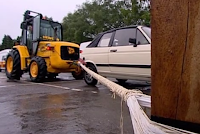(First posted 15th October 2017. The YouTube videos linked below are quite long. I don’t expect many will want to watch them through.)
 |
| Gosling’s Travels: Goole (1975, 26 minutes) |
In 1975, the radio and television broadcaster, Ray Gosling, made a film about Goole: a place I used to know well. The inhabitants were appalled. They had been looking forward to a film about a pleasant little town on the banks of the Ouse, with friendly folk in homely homes, about canals and railways, brave mariners who sailed the North Sea, the strange salt and pepper pot water towers, and the proud rise of a town from nothing to one of the country’s busiest ports in less than a hundred years: the story of the port in green fields.
But Ray Gosling was never going to stick to that. He homed in on the eccentric linguist who sought out foreign sailors to practise his Russian, businessmen who looked shifty and evasive, dockers who appeared scheming and workshy, the mysterious world of pigeon keepers, and, most embarrassing of all, the star turn, some young ladies who also liked to consort with foreign seamen, although not to practise their language skills. Goole: working-town low life in ragged abundance.
Watching again on YouTube, I see the problem. Right from the start, he goes for the jugular:
I’m walking the streets of a flat little town in Yorkshire that most of you will never have heard of: Goole. And those who do know where it is, between Doncaster and Hull, have nicknamed it Sleepy Hollow, because nothing has ever happened here that’s made the headlines in a newspaper. The place has no history worth putting into history books, and they don’t really manufacture anything.You might say: “What did you expect?” It was what Ray Gosling did. He was different from other broadcasters. He was cheeky and a bit common, working-class with an East Midlands accent, a university dropout, C-stream and proud of it. He made films about the little things of life, to him more important than the big things: caravans, allotments, sheds, the seedy, the left behind, the small-scale concerns of ordinary people. He was one of them. He wrote about them, ran things and campaigned for them.
The film is pure genius. He had seen the times they were a-changin’ long before Bob Dylan. He had tried to help the lively working-class community of St. Ann’s in Nottingham when the local council wanted to flatten and redevelop the whole district, but the community was lost in the end. He could see that Goole’s canal trains of coal-loaded compartments known as ‘Tom Puddings’, hydraulically hoisted into the air and tipped into the holds of ships, were nearing their end. Goole was a working museum that could not last, no more than the well-meaning vicar and police chief in the film, gullible anachronisms innocently trying to set up a wholesome mariners’ club not run by mariners. It was never going to supplant the Dock Tavern.
He had read On the Road and seen Rebel Without a Cause and The Wild One (a film banned in Britain) and understood the implications. He saw change in the hearts of young people rejecting their fuddy-duddy parents’ expectations. His autobiographies, Sum Total and Personal Copy are fascinating memoirs of the fifties and sixties. “We were the first generation to be able to busk with our lives” he reflected in 2006 in one of his last films, Ray Gosling OAP. And as he sat waiting for his cluttered Mapperley house to be forcibly sold due to bankruptcy, unable to move around the heaped accumulations of a lifetime’s work: piles of files, mountains of books, scattered nick-nacks; he said:
All my life, I’ve known we are what we collect, what we pick up, so my room with all the detail I’ve kept is what made my work, it was important, to me. The silly nick-nacks are not just nick-nacks, and they’re not silly.That is truly uplifting to hoarders like me: the glorious antithesis of decluttering.
| Ray Gosling OAP (2006, 59 minutes) |
I'll leave the last word to Ray himself, part of an article in the TV Times in 1975:
... I don’t think facts always tell the truth. And I’m not a promotion man for God, Queen and the Ruling Class in Britain Beautiful – but we do search for the good in a place. And try to film what people naturally do. Try to avoid dwelling on obvious eccentrics, though that’s difficult. We are such an individual fruit and nutcase lot. I’m not hawking any pet philosophy or seeking hidden meanings. The films are simply place-tasters.
I don’t know what you’re going to make of Goole. People live nearby refer to it as Sleepy Hollow, because nothing ever happens in Goole. That’s why I went. It’s one of the most forgotten places of England. Britain’s most inland port, 50 miles from the sea. Just as Bath doesn’t make enough of its spa water, Goole doesn’t make enough of its dirty canal water. Still it is the 11th port of the land. Behind the parish church, you can see hanging from the jib of a crane, Britain’s balance of payments. Steel: in and out. Russian timber imported. We got turfed-off a Russian boat, camera and all – nicely, but firmly. And Goole exports: coals for every purpose.
The great local row was in the pigeon club. Should the birds be flown, next season, from north to south? Opinion divided. I like Goole, I do hope I’ve done it justice.
There was a nice man we wanted to film there; Albert Gunn, dental mechanic, pigeon racer and performer in the amateur Kiss Me Kate at the Grammar School – but Albert was ill, so we couldn’t.
That’s the problem I find filming as against writing. With pictures we have to prove it. Our folks have got to perform in front of the camera.











